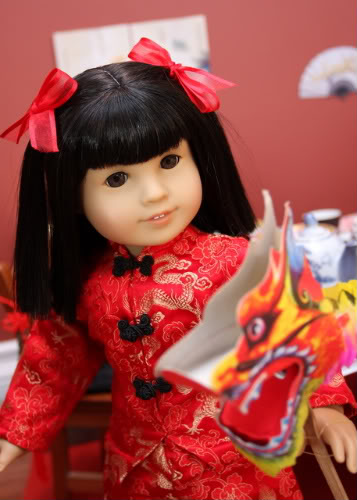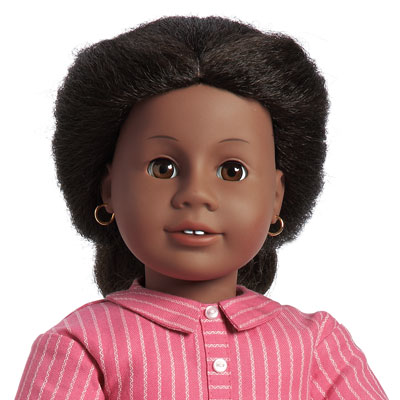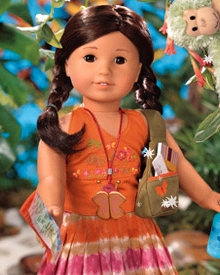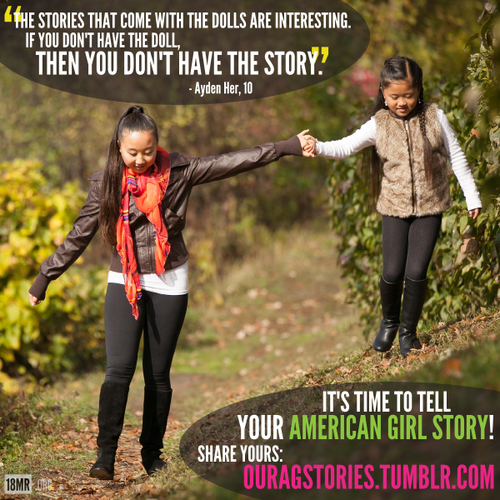
American Girl is a doll line started in 1986 by the Pleasant Company, and which was subsequently acquired by Mattel in 1998. Heralded as an attempt to infuse their dolls with progressivism and education, each of the 18″ American Girl dolls is sold with an accompanying booklet featuring a first-person narrative about a specific period in American history. Through the books and dolls, we learn about the American Revolution, slavery, and the Great Depression from a young female perspective.
Although early dolls have drawn from historical periods, in 1995, the doll line expanded with a line of contemporary dolls: American Girls of Today which was later rebranded as Just Like You, and finally My American Girl (which, along with the few named doll characters, includes a customizable line of dolls). This doll line features over sixty dolls with a variety of hair colour and skin tones, and Mattel asserted that this would “represent the individuality and diversity of today’s American girls”. Parents, the company said, would be able to let “every girl create a truly special doll that’s just right for her”.
Unfortunately, the truth is that My American Girl dolls really don’t represent the American girls of today. They aren’t just like us. They really do a terrible job of representing the individuality and diversity of today’s American girls.

Historically, American Girl has been criticized for the lack of racial diversity in its dolls. The first African American doll introduced to the line — Addy Walker — was a fugitive slave. The only doll to struggle with internalized racism is Cecile Rey, one of the historical line’s only other African American dolls, who is prejudiced against her White friend. A Latina limited edition Girl of the Year doll — Marisol Luna — was criticized for its depiction of Chicago’s Pilsen neighbourhood as dangerous and crime-ridden. Although two other Girl of the Year dolls were Asian American — 2011’s Kanani Akani is a Hawaiian hapa and 2006’s Jess McConnell is biracially Japanese American — neither doll is currently available for purchase. Currently, the only Asian American doll available through the line is Ivy Ling, a best friend character to a White doll in the My American Girl line: Julie Albright.
Earlier this year, Mattel announced it would be discontinuing four dolls, two of which are dolls of colour: Ivy, along with Cecile Rey, would no longer be sold. Yet, despite the company’s stated mission to “represent the … diversity of today’s American girls” and despite the fact that Asian Americans represent ~5% of the country’s population and are the fastest growing racial group in America, the company has not yet committed to replacing the Ivy Ling doll with another regular Asian American doll.
18MillionRising (@18millionrising) has responded with a large coordinated social media campaign. They are petitioning Mattel demanding a promise to create a new Asian American doll, and they have yet to receive a response (here’s the link where you can sign the petition). They have also created a Tumblr called “Our American Girl Stories” to demonstrate the many Asian American female stories that American Girl dolls could tell (here’s the link where you can submit your own AAPI American Girl story). (Correction: 18MR is inviting all WOC stories to their Tumblr, not just Asian).
I support this campaign, but frankly, I don’t think it goes far enough. There is so much more that American Girl needs to do to rebrand themselves for today’s American Girls; a new Asian American doll is just the tip of the iceberg.
First of all, let’s consider the Ivy Ling doll at the heart of this controversy. Why is the Ivy Ling doll relegated to best friend (or literal “sidekick”) status? The Ivy doll is also a veritable potpourri of Asian American tropes — her outfit is a red chi pao and she is sold along with a book titled “Good Luck, Ivy” where she struggles with family tradition. She is exactly everything you might imagine a non-Asian American company might come up with if they were trying to create a doll reflective of the Asian American experience — all schticky chop suey-ness and Orientalism. Finally, she is set in the 1970’s, in a period of significant political turmoil, racial profiling, and economic upheaval for the historic Chinatown district of San Francisco where she resides; yet none of that contemporary political history is reflected in her book.

More generically, the American Girl dolls are highly exclusionary to large swaths of today’s American girls. There are still a dearth of American Girl dolls of colour, and of the primary Asian American dolls the company has released, all of have been East Asian (one Chinese American, two biracially Japanese American); bizarrely, most have also been biracial. There has not yet been, to my knowledge, a Muslim American doll, a Southeast Asian or Pacific Islander American doll, or a contemporary Native American doll (the line’s only Native doll hails from the pre-colonial Midwest of 1763). The line’s only South Asian American doll is Sonali Matthews, a best friend character who didn’t get her own books, and who is biracially Indian American. Failure to depict any of these experiences, and cancellation of the line’s only Chinese American doll, creates a doll line that subtly reinforces the stereotype that Asian Americans aren’t quite American enough to be “American Girls”.
In addition, many of the company’s dolls in their My American Girl line feature narratives of economic privilege; this despite the fact that one-fourth of American children live in poverty, many of then children of colour. Perhaps this reflects whom Mattel thinks will be able to purchase an American Girl doll; priced at about $110 each, the dolls are prohibitively expensive for most working class families. Extra clothes and other accessories are between $20-40 each.
And frankly, I question the degree to which Mattel — the company that is, lest we forget, responsible for Barbie — is even capable of striking the right tone of progressivism, diversity and feminism with their American Girl dolls. Barbie still is shaped like an upside-down pear with permanently pointed toes on feet that would be the product of binding if they existed in real-life. Is this the company we really want presenting a varied and nuanced Asian American experience to our sons and daughters?
In the end, I support 18MillionRising’s campaign to take My American Girl to task for its cancellation of the Ivy Ling doll. Although parents can custom-create their own dolls from various parts on the American Girl website, American Girl dolls are defined by the characters and books. The absence of Asian Americans — and specifically the diversity of the Asian American experience beyond a single Chinese American doll from 1970’s Chinatown — is an oversight that demands correction. So, I strongly encourage you to participate in 18MR’s campaign by signing their petition and submitting to their Our American Girls Tumblr.
But I also urge Mattel and the American Girl lines to go a step further. There needs to be not just one or two, but several, racially diverse dolls in the line, and far more than just a token Asian American doll. These dolls must be more than just a mash-up of caricatured tropes; no more Asian American dolls dressed in chi pao and described as “lucky”. To more accurately and complexly reflect the experiences of people of colour, the company should strive to improve its own racial and gender diversity: while the demographics of Mattel’s total workforce are not available online, the company’s leadership is 90% male and exclusively White. Above all, dolls need to be priced so that they are accessible for all children, and not just those coming from upper middle-class families. It would be nice if most Asian American children in poverty could actually afford the Asian American doll that Mattel will hopefully replace Ivy Ling with.
In short, if Mattel is truly dedicated to reflecting the diversity and experiences of today’s American girls with their American Girl dolls, they should actually do that. Today’s American girls aren’t predominantly rich and White, these dolls shouldn’t be either.

